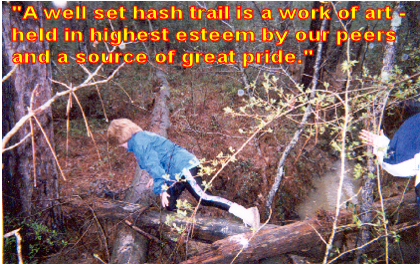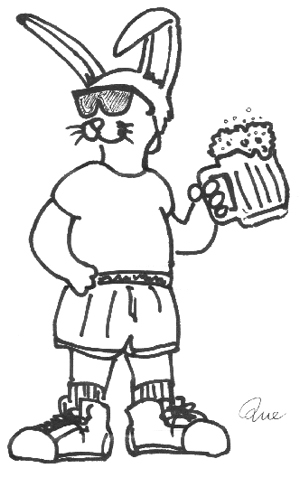Hash House Harrier Trail Manual, 2011 EditionPreface for this Edition of the -Harrier Trail Manual
This effort began a long time ago, originally in the Okinawa HHH. Then GM, Ichabody Crane (later founder of the Samurai HHH and known as Uncle Milty), determined that the hares were getting a little too creative or even scarce in their marking. He put together a sheet of hare marking concepts that is the foundation of the standard markings found at hashes worldwide either as descendants of this style or in coincidence by virtue of their simplicity and common sense.
As On-Sec of Okinawa at the time, I kept a copy for my archives and expanded on it as I founded other hashes in my travels throughout the years. I would add a little here and there to the tradition as experience taught me what worked and what didn't. What you see now is the culmination of over a quarter century of haring literally hundreds of runs and mismanaging over a dozen hashes. The markings you see in this book have been successfully used around the world. I have personally set trails for dozens of interhashes using this tradition, including the USA Nash Hash and EuroHash. The success of those trails speaks for itself.
One word of caution: This is not a rulebook! I have been constantly criticized for daring to write down a trail marking tradition, but the praise for assisting thousands of hares over the years who have benefitted from the modest guidance here more than makes up for the nay-sayers. You should always remember that every hash is independent and there is no international Rules authority on this subject. What I have written here is simply a few suggestions of a well-tested tradition that I share with you. Take a little here and a little there as you desire, and disregard anything that might conflict with your own local tradition. Local trailmarking tradition always prevails!
In the past I divided the trail marking traditions into live and dead hare books called, Stray Dog's Manual for Live Hare and Book of the Dead Hare. I have since witnessed that some hashes are more flexible, allowing some dead trails and some live trails depending on the hare. Also, basic marks are the same, with some specialized holding checks thrown in for dead hare that are not fair in live hare. So I have combined the books here, separating the general marks fair in live hare hashing from the specialized marking used mostly on dead hare trails. It is a little recognized fact that successful hares of both live and dead hare traditions should still scout trail, know the markings and understand trail strategy. So in combining the books, I still emphasize the mastery of good trails, not styles of social interaction. Your comments are welcome and I hope this new volume helps you in some way.

|